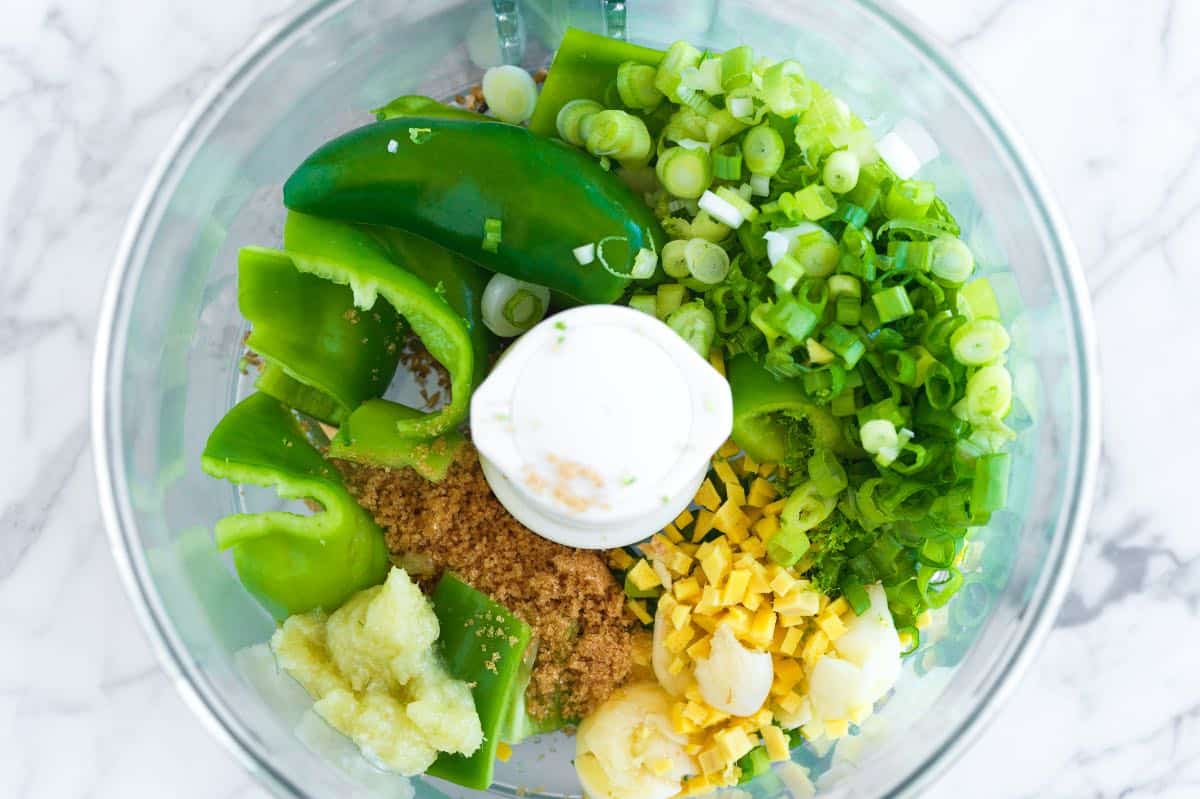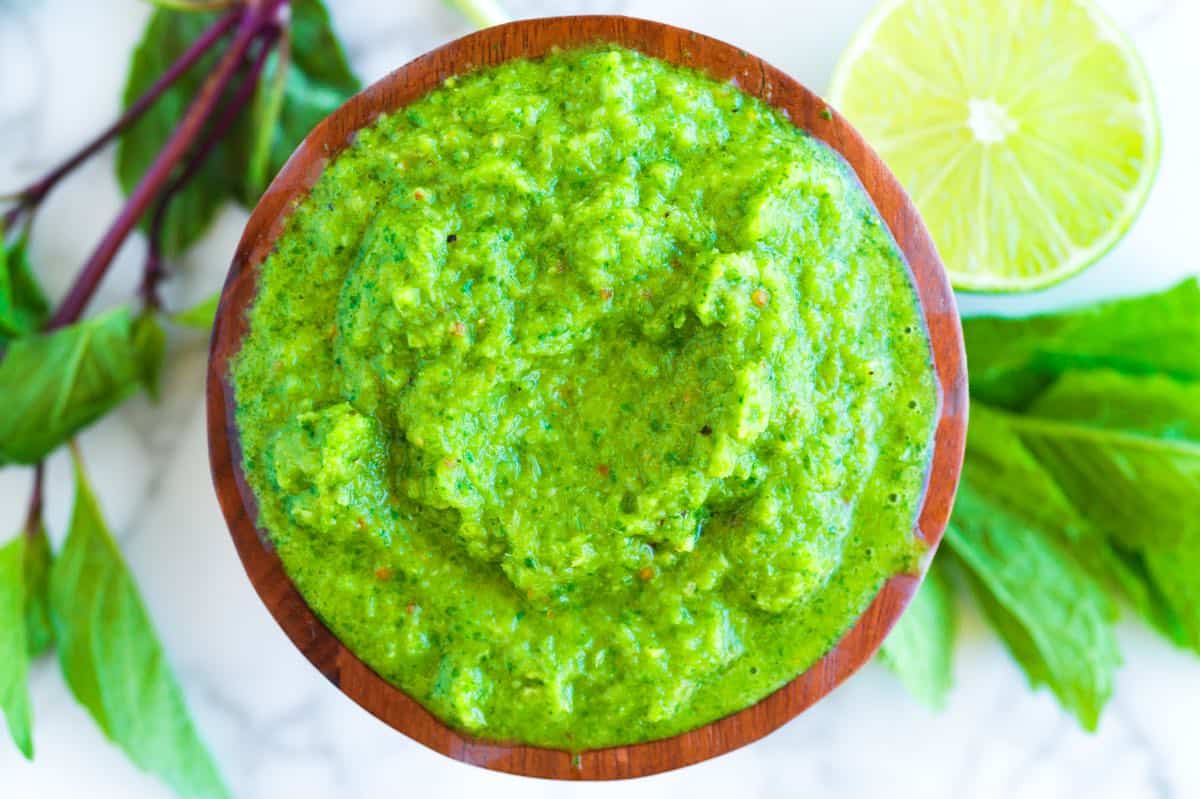Homemade Green Curry Paste Recipe

Make your own Thai green curry paste from scratch with this easy recipe. The vibrant green is enough to make you smile, but wait until you take a bite!
This green curry paste is perfect for Thai green curry, but also adds a spicy flavor to fish, chicken and vegetables. Thanks to mint and basil, this is a bright and super Herby, and you can easily control the spice level. Thai green curry is usually hot, but if that’s not your style, you can easily tune things down with our recipes. You will never go back to the store to buy!
We love Thai curry, but store-bought curry paste can have a lot of flavor. That’s why we took the opportunity to learn how to make ourselves, and now, after sharing three versions (red curry paste, yellow curry paste and this green), we’re so glad you’ve joined us!
Key Ingredients
- chili: All curry pastes that inspire flavor are designed to be as close to the real as possible while using the ingredients that are usually available. For this traditionally hot and spicy green curry sauce, we are using jalapeno. You can swap it for Serrano or use Thai green chili (it’s really punchy), but I find the jalapeno works great. For mild curry, remove all seeds and membranes from the pepper before processing. In addition to the jalapeno, we also use mild Anaheim pepper, which adds a fresher green flavor.
- Coriander seeds, garlic, scallion and ginger: These aromatics form the basis of our curry paste, guaranteeing an absolutely irresistible flavor. For green onions, look for green ones that are more green than white.
- Lemongrass sauce: Without lemongrass, Thai green curry paste is incomplete! I like the convenience of the lemongrass paste (sold in tubes), but if you are working with fresh, check out the tips below the recipe. I also made our sweet and sour meatballs with lemongrass sauce.
- Fish sauce and lime: These bring everything together to add brightness, umami and a light salty flavor. Although many curry paste recipes use dried shrimp or shrimp paste, fish sauce is a good choice and can be easier to find (if vegetarians omit fish paste). My pantry had red boat and three crab sauce.
- Brown Sugar and Sesame Oil: We don’t use much, but a little sugar and sesame oil balances brighter, spicy ingredients like lime and chili.
- Green Herbs: We use a powerful trio of fresh mint, basil (Thai basil is the best, but Italian basil works) and cilantro. For mint and basil, use leaves. For cilantro, use stems. They add texture to the paste and rich cilantro flavor.
How We Make Homemade Thai Green Curry Sauce
Our recipes are as authentic as possible when using ingredients that you can find easily. Here are some tips to make it the best:
Tip 1: Adjust the calories to your taste. We swap traditional Thai peppers for the more common jalapeno. Of course, if there is Thai chili, you can use Thai chili, but our recipes guarantee a delicious green curry anyway.
- For mild curry, remove the seeds and white membrane.
- For spicy curry paste, use a jalapeno paste with the remaining seeds.
- For real and very hot curry, add two jalapenos or add two Thai green chilies (those green chilies are really easy!).

Tip 2: Fusion to almost smooth. I use a food processor, let it run, scraping the sides every once in a while until my mushy paste is. The blender works well too (and may even make you smoother paste). Just keep blending until it looks similar to our photos.
Tip 3: Use your homemade green curry paste. The most common use is to make classic green curry with coconut milk. I use 4 to 6 tablespoons for a can of whole fat coconut milk 13.5 oz.but you can adjust it to your preference. Whatever you do, make sure to quickly cook the curry paste some oil before adding the coconut milk. This quick step “flowered” the spices and aromatics, releasing their full flavor. If you don’t use it for curry, get creative! It adds a fresh spicy flavor to mayonnaise, meatballs, butter, fish, chicken and more.


Homemade green curry sauce
-
Prepare
-
All
I’m craving a curry made with this homemade green curry paste. Use 4 to 6 tablespoons of paste to make a 13.5 ounce can of whole fat coconut milk. You can then adjust from there. Cook the curry paste in a small amount of oil to exude all the flavors (trust me, that’s big). For red curry, use our homemade red curry paste or mild curry, see this yellow curry paste.
Adjust the calorie level: For mild curry, remove the seeds and white membrane of the jalapeno; for spicy curry paste, use 1 mexican jam, the remaining seeds. For real and very hot curry, increase to 2 Mexican jam or add 2 to 3 Thai green chilies (they really pack a punch!).
Make 1 cup
You will need
1 teaspoon cilantro seeds
5 black peppers
1 jalapeno, or more spicy
1 Anaheim pepper, remove seeds and chop
4 cloves and garlic, peeled and lightly crushed
1 thumb-sized fresh ginger, peeled and chopped (1½ tablespoons, about 10 grams)
4 green onions, greener the better, chopped
4 teaspoons lemongrass sauce
1 tablespoon brown sugar
1 lime, soft and juiced
2 teaspoons fish sauce
1/4 cup (5G) packaged mint leaves
1/2 cup (10g) packed basil leaves, preferably Thai basil
1/2 cup (30g) cilantro stems
1/2 teaspoon toasted sesame oil
1/2 teaspoon fine sea salt
direction
1Grind spices: In mortar and pestle, grate the coriander seeds and pepper. Transfer the ground spices to the food processor bowl. (If you don’t have mortar and pestle, you can crush them with the back of a heavy pan or the bottom of the can.)
2Prepare the peppers: For a spicy paste, cut the jalapeno in half and add to the food processor. For a milder paste, cut the jalapeno in half and remove all seeds and white film before adding.
3Make Curry Paste Base: Add Anaheim pepper, garlic, ginger, scallion, lemongrass sauce, brown sugar and lime peel to the ground spice and jalapeno. Pulse until a rough paste forms.
4Complete the paste: Add fish sauce, mint leaves, basil leaves, coriander stems, sesame oil, salt and lemon juice. Continue to pulsate until the mixture becomes smooth, mostly uniform paste.
Adam and Joanne’s Tips
- Store in the refrigerator: Add your homemade curry paste to a clean glass jar, add a thin layer of avocado oil on top and store it in the refrigerator for up to 1 week, possibly longer. The green may be slightly dimmed.
- Store in the refrigerator: You can freeze it for up to 3 months. Divide the paste into small freezing safety containers or ice cubic trays. If using an ice cube tray, freeze until freezing, pop them out, and store them in a freezer-safe airtight container.
- Lemongrass sauce: I buy refrigerated lemongrass sauce using squeezeable tubes sold near fresh herbs.
- Using fresh lemongrass: Cut the top and bottom of the stem. Then, peel off the solid outer layer until it reaches the tender pale yellow core. Finally, slice the stems and chop them as much as possible, or use a food processor to chop them. If you make a larger homemade lemongrass paste, keep it in an airtight container in the refrigerator for a few days, or freeze it in an ice cube tray, transfer it to a freezing bag, and freeze it for up to 3 months.
- curry: Start with 3 to 4 tablespoons of curry paste per cup of coconut milk. You can add more at any time later!
- For marinade/other dishes: Start with 1 tablespoon curry sauce per pound per pound.
- The nutrition facts provided are estimates.
Nutrition per serving
Service size
1 tablespoon
/
Calories
15
/
Total fat
0.2g
/
Saturated fat
0G
/
cholesterol
0mg
/
sodium
167.9mg
/
carbohydrate
2G
/
Dietary fiber
0.4 g
/
Total sugar
1G
/
protein
0.3g

We are Adam and Joanne, a couple who are passionate about cooking and sharing delicious, reliable recipes since 2009. Our goal? Inspire you to enter the kitchen and cook fresh and delicious meals confidently.




